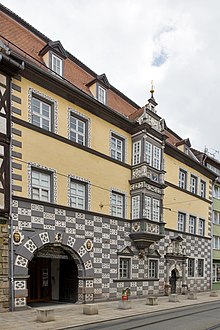Johannesstrasse (Erfurt)
The John Street is an old main street in the old town of the Thuringian capital of Erfurt . It connects the Anger in the south over 1200 meters in length with the Johannestor in the north. There it turns into Magdeburger Allee .
history
Johannesstrasse first appeared in 1289 as platea sancti Johannis . This makes it one of the oldest streets in Erfurt. It was named after the Johanneskirche ( patronage of Johannes the Baptist ), which was demolished in 1819 , of which only the Johannesturm on the corner of Franckestrasse is still there today. The whole quarter was later named after it, so the Johannesmauer (partially preserved) and the Johannestor as well as the Johannesvorstadt also existed earlier. In the Middle Ages, however, the suburb was not today's Johannesvorstadt , which was built after 1870 , but the northern area of Johannesstraße between the inner and outer Johannestor. It was enclosed by the new city wall built in the 14th century and has been part of the city of Erfurt ever since. The Johannesufer also took over the patronage.
In 1950 the street was renamed Leninstrasse, which was reversed after the reunification in 1990.
Traffic significance
Johannesstrasse has had an important traffic function since it was built: It connected the Anger, the main trading place of the woad, with the Johannestor, where the road to Magdeburg led out of the city. There were also significant woad growing areas in this direction. Over the centuries, Johannesstrasse has remained a main artery on which trams have been running since 1883 (the Stadtmuseum / Kaisersaal, Augustinerkloster and Boyneburgufer stops on lines 1 and 5). Starting around 1900, private transport was relocated from the southern part of Johannesstraße to the parallel Johannesring (today's Juri-Gagarin-Ring ). Today, the entire area between Anger and inner Johannestor is traffic-calmed and reserved for trams, pedestrians, cyclists and residents. The northern part, the former suburb between the inner and outer Johannestor, still serves as the main thoroughfare today, so the Juri-Gagarin-Ring ends on Johannesstrasse at the inner Johannestor.
Development
Today there are buildings from the last 500 years and older sacred buildings on Johannesstraße. The merchant's church is at the southern end of the street leading to the Anger . The baroque merchant's parsonage was removed for traffic reasons during the GDR era. A Matthias church was located on the corner of Futterstraße until it was completely demolished in 1818 and the Johanneskirche was on the corner of Franckestraße until 1819. The Johanneskirche tower was preserved and now serves as the bell tower for the Augustinian church.
One of the outstanding secular buildings on Johannesstraße is Haus zum Stockfisch , a Renaissance town house that now houses the Erfurt City Museum . Other Renaissance town houses also shape the image of the street, especially in the southern part. In addition, neo-classical, historic and very simple merchant houses are also part of the development on Johannesstrasse, on which there are a total of around 170 houses. Some historical buildings - opposite the confluence with Futterstraße - were replaced by architecturally undemanding new buildings during the GDR era.
In the last few years of the GDR, entire old town quarters in the area between Augustinerstraße and Boyneburgufer were demolished and built with prefabricated buildings, but these were built in the so-called "old town-friendly construction" with four floors and a pitched roof.
The street and sidewalk areas from the Anger to the Johannestor were extensively renovated from 1999 to 2002. Today Johannesstrasse is a shopping street with many, mostly quite small, shops. However, the vacancy rate in Johannesstrasse is also significantly higher than in other parts of Erfurt's old town. In sections, almost every second building is empty. After most of the streets in the old town had already been completely refurbished, building activity increased again along Johannesstraße from around 2007, so that here too the revitalization of empty old buildings is progressing. This is supported by rising rents and a high demand for residential and commercial space in the city center. In 2010, the prefabricated buildings on the Johannesturm built in the late 1980s also underwent an initial renovation.
Individual evidence
- ↑ Steffen Raßloff: Model houses for prefabricated buildings in inner cities. In: Thüringer Allgemeine, June 30, 2012
Web links
Coordinates: 50 ° 58 ′ 51 ″ N , 11 ° 2 ′ 0 ″ E



